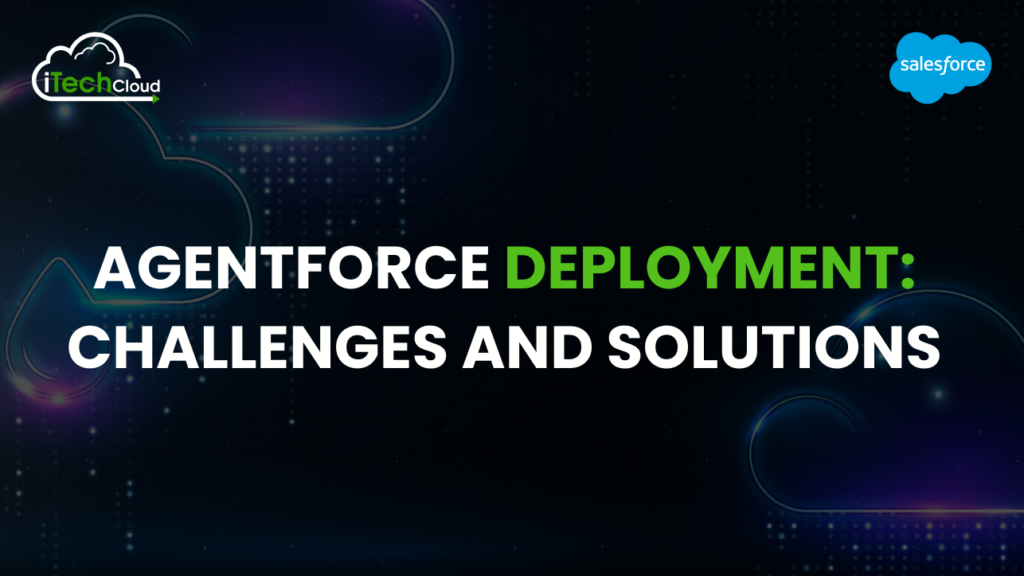Agentforce Deployment: Challenges and Solutions

The introduction of Salesforce Agentforce marks a significant advancement in the realm of autonomous AI agents, promising to revolutionize how businesses interact with customers and manage internal processes. However, deploying such a sophisticated platform comes with its own set of challenges. This blog explores the potential hurdles organizations may face when implementing Agentforce and offers practical solutions to ensure a smooth transition.
Table of Contents
What is Agentforce?
Agentforce is an agentic AI platform developed by Salesforce, designed to enable organizations to build, customize, and deploy autonomous AI agents. These agents can perform a variety of tasks across customer service, sales, marketing, and more, functioning independently while also being integrated with human operations when necessary.
Key Features of Agentforce Deployment
1. Autonomous Operation:
Agents can operate independently, retrieving data and executing tasks without constant human intervention.
2. Integration with Salesforce Ecosystem:
Seamlessly connects with existing Salesforce applications like Service Cloud and Sales Cloud.
3. Real-Time Adaptation:
Agents can adjust their operations based on live data inputs.
4. Security Protocols:
Incorporates the Einstein Trust Layer to protect sensitive data from third-party access.
Challenges in Agentforce Deployment
1. Integration Complexity
- Description: Integrating Agentforce with existing systems can be intricate. Businesses often have legacy systems that may not easily connect with new technologies.
- Solution: Conduct a thorough assessment of current IT infrastructure before deployment. Utilize Salesforce Data Cloud for seamless integration, ensuring that all data sources are connected and accessible to the agents from the outset.
2. Training and Adoption
- Description: Employees may resist adopting new technologies due to unfamiliarity or fear of job displacement.
- Solution: Invest in comprehensive training programs that focus on how Agentforce enhances employee roles rather than replacing them. Encourage a culture of collaboration between AI agents and human employees by demonstrating successful use cases.
3. Performance Monitoring
- Description: Once deployed, it’s crucial to monitor agent performance continuously. Poor performance can lead to customer dissatisfaction.
- Solution: Establish clear KPIs for agent performance such as response times and accuracy rates. Use dashboards for real-time monitoring and make adjustments based on performance data.
4. Customization Needs
- Description: While Agentforce provides templates for agents, businesses often require custom solutions tailored to their specific needs.
- Solution: Leverage the Agent Builder tool within Agentforce to customize workflows and actions according to business requirements. Regularly review and update these configurations to keep pace with evolving business goals.
5. Data Management
- Description: Ensuring data quality is essential for the effective functioning of AI agents. Poor data can lead to inaccurate responses and actions.
- Solution: Implement strict data governance policies before deploying agents. Regularly clean and update data sources to maintain high-quality inputs for the AI system.
Best Practices for Successful Agentforce Deployment
1. Define Clear Objectives
Before initiating deployment, outline specific goals for what you want to achieve with Agentforce whether it’s improving customer service response times or enhancing sales conversions.
2. Engage Stakeholders Early
Involve key stakeholders from various departments early in the planning process to ensure alignment on objectives and expectations.
3. Iterative Testing
Conduct iterative testing of agents in controlled environments before full-scale deployment. This allows for identifying issues early on and refining agent functionalities based on feedback.
4. Ongoing Training
Provide continuous training opportunities for employees post-deployment to help them adapt to changes and leverage the full capabilities of Agentforce effectively.
5. Regular Maintenance and Updates
Schedule regular maintenance checks and updates for agents to ensure they remain aligned with business needs and incorporate new features from Salesforce updates.
Conclusion
Agentforce presents a transformative opportunity for organizations aiming to enhance operational efficiency through autonomous AI agents. However, navigating the complexities of integration, training, performance monitoring, customization, and data management requires careful planning and execution. By addressing these challenges with proactive solutions and adhering to best practices, businesses can maximize the benefits of Agentforce while ensuring a smooth transition into this new era of AI-driven operations.

